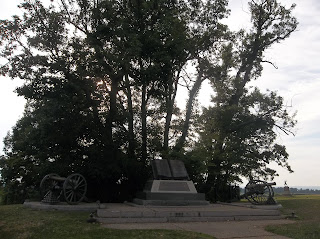Here are the final photos of the Gettysburg battlefield. These cover the Wheatfield, Peach Orchard, Plum Run, Pickett's Charge and the High Water Mark.
On the second day, General Longstreet sent his 1st Corps against the Union left across this field and the nearby Peach Orchard. Fierce fighting raged all day. The Union III Corps was effectively destroyed trying to defend too big an area, but they prevented the Confederates from reaching the heights to the east.
 |
| The Peach Orchard, with the modern descendants of those trees gracing the place today. |
 |
| Looking east toward the main Union positions. |
 |
| Memorial to the famous NY Fire Zouaves. |
 |
| Plum Run Creek. |
 |
| Father William Corby, chaplain to one of the NY regiments. |
 |
| The Pennsylvania Memorial. |
 |
| Looking south toward the Round Tops from the viewing platform atop the memorial. |
 |
| Looking west toward the Confederate lines. |
 |
| Looking north toward the Seminary. |
 |
| Spangler's Spring, at the southern end of Culp's Hill. |
 |
| The area around the Spring, with the Indiana memorial. |
Spangler's Spring turned into a cockpit during the fighting on the second day. It formed the extreme right of the Union line, the barbed end of the 'fishhook.' Although the Union retired at nightfall the Confederates had failed to gain an advantage.
The third day saw the famous charge of Picket's Divisions across the center of the battlefield toward Cemetery Ridge.
 |
| Looking from the Virginians' positions toward the Copse of Trees. |
 |
| Looking back at the Confederate lines. |
Longstreet wanted to lead the charge but Robert E. Lee forbade it. After a ferocious barrage from Confederate artillery 12,000 men set out from the cover of the trees above, marching across the undulating ground toward the waiting Union soldiers atop Cemetery Ridge.
 |
| Cemetery Ridge. |
 |
| The Angle, and the High Water Mark of the Confederacy. |
 |
| Memorials to the many Union gunners who defended the ridge. |
 |
| The stone wall atop the ridge. Few rebels managed to cross it. |
Lee saw the undulating ground might serve to conceal Pickett's onrushing troops from Union fire for at least part of their march. He proved wrong, and admitted it when Pickett led his battered and bloody survivors back to their lines.
Lee rode out a little way to meet his men as they retired. "It has been all my fault," he was heard to say. The attack had cost his army 6,000 irreplaceable veterans.
 |
| The scene of Lee's meeting with Pickett. |
The next day the Army of Northern Virginia began a weary retreat, back across the mountains they'd crossed with such high hopes mere days before.
* * * *
That's all for my recent adventures on the Civil War battlefields. I'm making some progress on the steam gunboat model for Colonial gaming. More on that another time.


























It's been wonderful sharing the experiences of the battlefields, many thanks A.J.
ReplyDeleteFantastic... you're walking in the very place where brave men fought and died, and they say history is dry and uninteresting...! Great pictures..
ReplyDeleteThank you, gentlemen! Yes, it's not hard to picture those far off days there on the ground. the Sunken Lane at Antietam has an aura all its own. Gettysburg is such a huge battlefield it does take a long time to understand it all, as does Antietam. It's best to visit during the cooler months of Autumn. Walking that ground in 90f+ heat is not for the faint hearted. How those men of yore did it wearing woolen uniforms beats me!
ReplyDeleteI visited this battlefield many years ago it's set up to be very friendly for tourists and is a great experience. Thanks for posting your pictures they reminded me of a good time!
ReplyDelete